
|
How
to rebuild a crankshaft
|
|
|
|
|
Right,
now you’ve made the stand this what you do with it.
To
split the crankshaft, firstly put the stand in the vice with the two bits
pointing upwards.
Place
the crank with the timing side shaft facing upwards, on to the stand, there
is no need to use the clamp that you made just yet! Firstly, undo the screws
and remove the locking plates these can be a bit stubborn to get off, but
you can insert a screwdriver under them and gently praise them off, taking
care not to bend them as you will re-use them. Using a long ratchet or
breaker bar undo the nut, the reason that you put it in the stand this way
up first is because BSA cranks are keyed on the primary side of the crank.
With the nut undone get a copper/ hide mallet and strike the timing side
flywheel on the side, try to use one sharp tap rather than lots of little
ones, the flywheel should then break off its taper and can be removed.
|
|
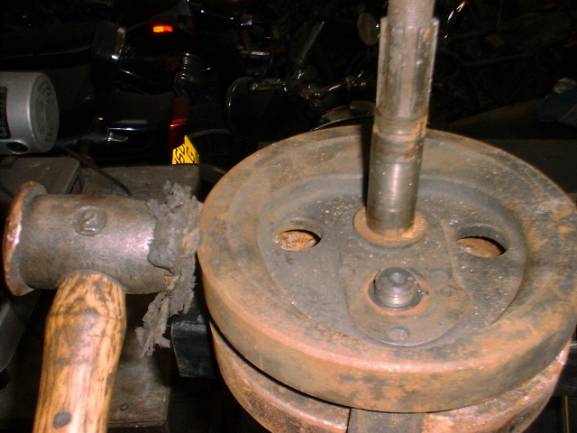
|
|
When
you have removed this flywheel, you can take off the connecting rod and the
bearing cage and rollers, now you can remove the crankpin, by turning the
crank over in the stand and undoing the nut on the remaining flywheel, then
simply give the crank pin a sharp tap with the mallet on its threaded end.
|
|
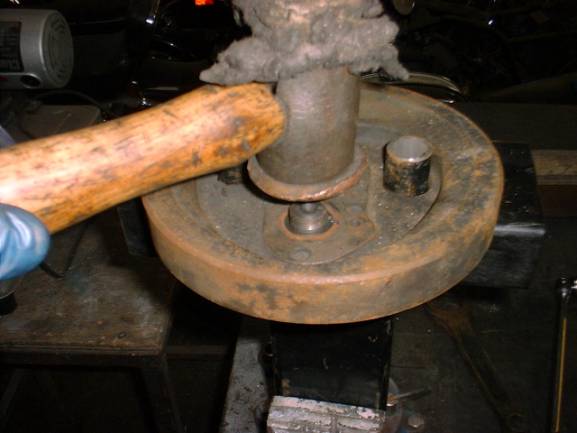
|
|
Now
the crank is split, you should clean up all the components, personally I
bead blast them and then use a “Scotch” pad or wire wool, the reason I
use a two step process is because if you just bead blast them they tend to
rust rapidly, if they are given a bit of a polish is this tends to make them
a bit more rust resistant, besides the fact it looks pretty!!!
This
picture below shows the standard that you should try to achieve
|
|
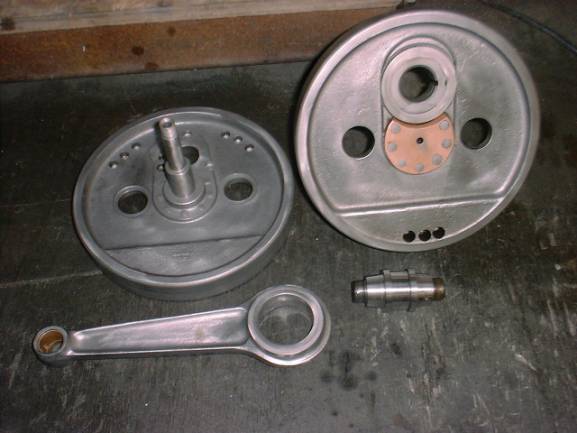
|
|
The
reason that you give everything such a good clean is that the longer you
handle the components, the longer you have to notice any defects, if you
just give them a quick clean you may miss a slight crack in the flywheel or
the loose rivet on the shaft.
Now
the components are clean, you can now decide on the best course of action to
rebuild it, you can ignore all of this if you have a new crankpin and rod
set! As we are trying to save you money we’ll do this the cheapest way!
Firstly
decide where most of the wear is, if you have a micrometer you can check the
wear on the rollers, but you usually find that they are worn 0.002 inch or
0.003 inch and the rod race in the connecting rod has a tiny bit of wear
along with a couple of pits in the crankpin (this is what I usually find!)
if there is a lot of pitting or deep witness marks where the rollers have
sat stationary on the crankpin for a long time and the acids in the oil from
combustion have etched the surface of the crank pin,
you may as well throw it away and get another one!
What you have to decide is where most of the wear is and concentrate
on trying to remove the wear or damage on that particular component and just
basically refresh the surface on the other component.
To
clean up the crankpin, the best way is to put it in the lathe and with emery
tape and polish the surface this can also be achieved by clamping the two
ends of the crankpin in the vice and using the emery tape in a backwards and
forwards motion, making sure in this instance that the tape does a full loop
of the pin so that it cleans it up evenly this will actually take quite a
while so don’t be scared of taking off too much, obviously doing it in a
lathe is a lot quicker this should be done irrespective of the pin looking
in good condition as you will be using a long one piece roller and
there will be a microscopic ridge where the ends of the two separate were
running alongside each other. See photo below
|
|
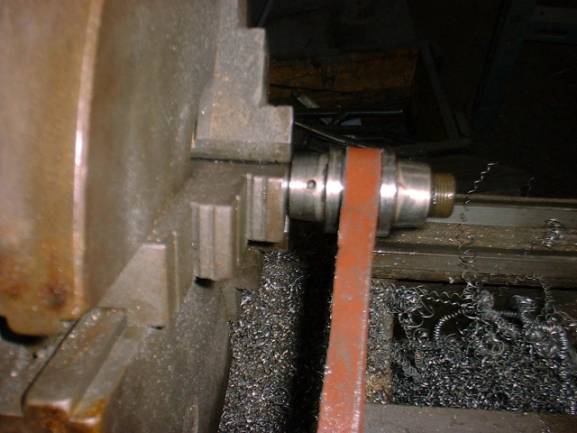
|
|
To
clean up the connecting rod race, it is a bit more difficult for the amateur
to achieve. I personally use a honing machine but I’ve got a big
workshop!! You can use a spring type hone running at a slow speed but this
does not remove any slight ovality in the race a better method is to use a
Delapena hone or better still take it to an engine reconditioners and get
them to do it. Basically you
are trying to get a good fit with the new rollers and restore the running
clearance on the big end, usually you will find that the 0.001 inch oversize
rollers won’t fit in there straight away, and you have to make the
decision to remove a bit more metal on the most worn/ damaged surface. In
some instances it may pay you to take the whole lot to an engine
reconditioners and explain to him the contents of this section and let him
sort it out for you. The cost shouldn’t be much, I have all the machinery
and it only takes about a quarter of an hour to sort it out. The photo below
is of the connecting rod being cleaned up on a horizontal honing machine.
With
regard to the tapers in the flywheels, check them for ridges near the
outside edge where the crankpin has pushed up a sliver of metal when it was
initially tightened, if one is visible you should try to remove it by gentle
filing, taking care not to damage any other part of the taper, the tapers
sometimes wear when the engine is used as a brake, one flywheel will try to
ride over the other and this movement over a period of time will cause the
taper to wear. You can also check the amount that the flywheel grips the
crankpin, by looking for a wavy line in the taper, another way is to put
some engineers blue on the taper and turn it a few times and see that it has
been removed evenly. There is no real way on a BSA to machine the tapers as
this would be too close to the shoulder on the crankpin and you couldn’t
be sure that it wasn’t only gripping just on the shoulder, Old M20 cranks
are cheap so it would probably pay you to obtain another set in this
instance. Don’t even think about using grinding paste unless you want to
make matters worse!
|
|
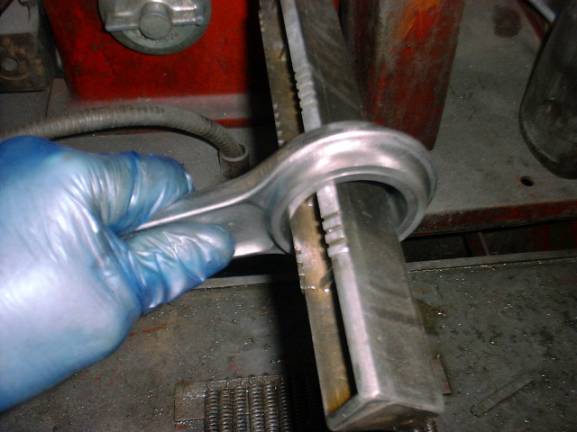
|
|
A
nice finish on the connecting rod race should be a nice crosshatched finish
at about 120 degrees.
Now
would be a good time to put a new small end bearing in, you can do this by
using a socket that is slightly smaller that the outside diameter of the
bushing but still has a large enough diameter to not jam in the bush as you
press it and on the other side another socket whose inside diameter is
larger than the outside diameter of the bush but not too big as you want it
to sit on the “eye” of the connecting rod. Simply sandwich the rod
between the two sockets and tighten the vice, the bushing should be slowly
pressed out into the larger socket Hey Presto and its out! To put the new
one in simply squeeze it in using the vice, don’t forget to drill the oil
hole in it then, just ream it out.
Now
you are ready to reassemble the crankshaft!
Firstly
place the woodruff key in the crankpin and ensure that there are no traces
of oil or grease on the tapers of either the crankpin or its mating part on
the flywheel, if there is the pin will not seat properly in the taper, it
would be as if it is floating on the oil and will never stay tight where you
put it so it should be cleaned with thinners or acetone, needless to say
that you have blown out the crankpin and the oil way in the mating flywheel
before you start this and made sure that everything is scrupulously clean!!
Place
the crankpin in the flywheel and tighten up to 100 ft lbs, I find that if
you do it in stages it moves when you do the final tightening, when it is
torqued up try on the lock washer and see if it lines up, if it doesn’t
you can tighten it up a little bit more until it does, but before you do try
both lock washers on both ways round, it may fit as the lock washers are
sometimes slightly different. If the lock washer doesn’t line up, never
slacken it to get it to line up!
|
|
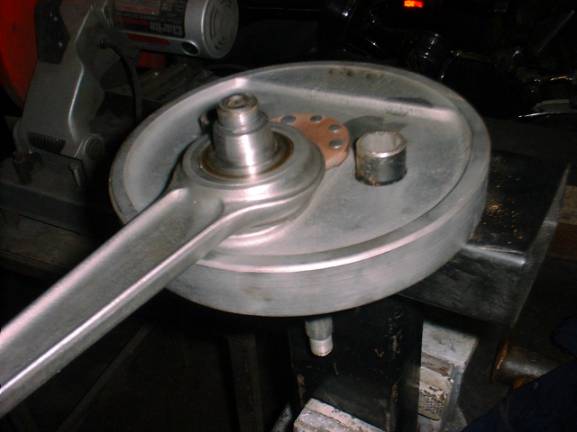
|
|
Now
after putting the bearings in and the rod on, you can place the other
flywheel on top and just nip the nut to about 20 ft lbs, then place the
truing clamp as close to 90 degrees away from the crankpin as you can, this
needs tightening up pretty tight to get the flywheels in line then you must
slacken it off and have it at about 15 ft lbs this initially trues the
flywheels then lets them pull together evenly (so that the flywheels don’t
just pull together by the crankpin and leave the side opposite so tightly
clamped that they don’t pull in evenly) Now all you have to do is tighten
it up to 100ft lbs and once again check that the locking washer lines up.
This is your crankshaft now assembled.
Now
the fun bit!!! (Not)
It’s
time to true the flywheels, this is quite hard to explain and you’ll find
that the more you do the easier it becomes, but it does help to do it in a
set order. The first thing you’ll need is a lathe or a crank truing stand.
If you have a lathe you will need two centres, you could machine up another
one from round bar, one in the tailstock and leave the one you’ve just
machined in the chuck!
First
things first you must make sure that the flywheels do not run out across
their outside edges, it is best to do this on the stand when you’ve
tightened up the nuts, you will find a digital vernier caliper best for
this, all you have to do is take a measurement across the flywheels by the
crankpin, and another one directly opposite, then another at 90 degrees to
the last and then another directly opposite this one, this will tell you
where the run out is, if one side is too high you can squeeze it in the vice
or with a G clamp, the main reference point for all these measurements is
the crankpin as all sides of the flywheel should be in line with it. If the
opposite side to the crankpin is too small a measurement you can open up the
gap between the two flywheels with a pair of tyre levers levering them
apart. See the photos below to see what I mean.
|
|
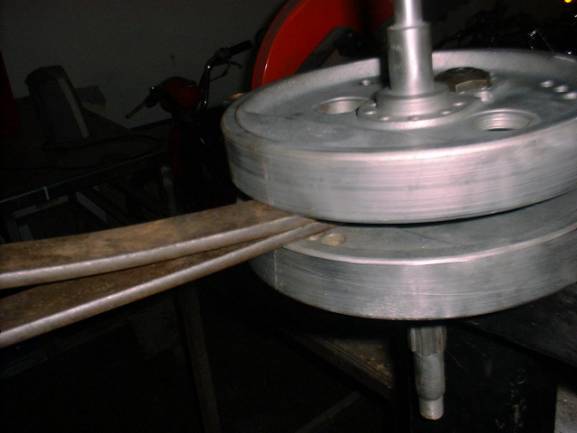
|
|
The
picture below shows where the measurement should be taken, then at 90-degree
intervals around the rim, if the measurement is larger than on the crank pin
side, you must squeeze the flywheels together, and if the measurement is
smaller you must spread the flywheels with the tyre levers.
|
|

|
|
When
you have got the measurement to within about 0.002 inch or less, you can now
put the crank into the lathe or truing stand to do the final truing. You
should place the crank in the stand and adjust the tailstock so that the
crank has no lateral play, in other words there should be no free play so
the crank could move side wards and give a false reading and at the same
time not so tight that it is squeezing the flywheels together. Now it is in
the stand correctly positioned the following picture shows the crank in the
stand.
|
|
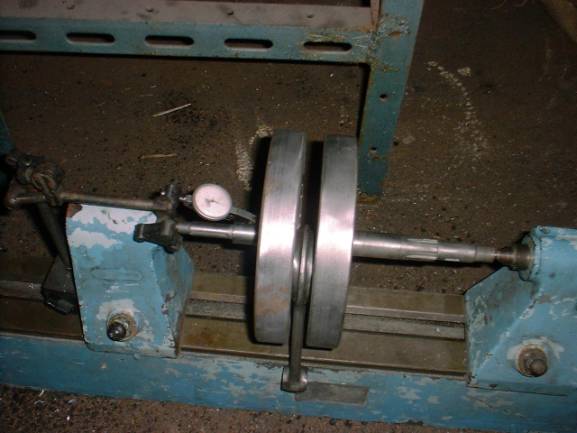
|
|
Place
your dial gauge on one of the shafts, this is the shaft that you now use to
index the run out from, you can use two gauges if you’ve got them as it
helps you understand why you have run out where you have it, but you can
still do it just as well with one. My own gauge is of the Verdict type but
you can also use the Mercer type, if you can get one that is calibrated in
0.0001 this is better as it allows you to see the run out sooner and as a
sweeping movement as opposed to a sudden “blip” from the needle.
Now
you must understand the types of runout.
|
|
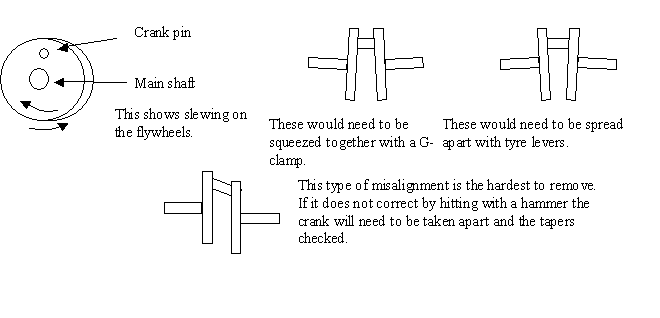
|
|
By
understanding where the misalignment is you can correct it by carefully
hitting the flywheel rim in the appropriate place, as to how hard you have
to hit it is a matter of experimentation, it is better to hit it not hard
enough than to hit it too hard and throw the whole assembly out too far in
the other direction. It is better to start off giving it a “sharp tap”
than to hit it with a “crack”. Sometimes with this jig you can get it to
within a couple of thousandths of an inch first time, and other times it may
take half an hour to get it spot on, it will always true up easier if you do
it in the logical way, by sorting out the run out on the flywheel edge, then
tackling the other types of run out.
The
hardest type to get trued up is where one flywheel is higher than the other
one, and by experience usually, the only way to sort this out is to split
the flywheels and try again after using a little emery paper on the tapers
hoping that it will allow the taper to reseat itself in the correct place,
the picture shown below shows an exaggerated view of the taper problem.
|
|
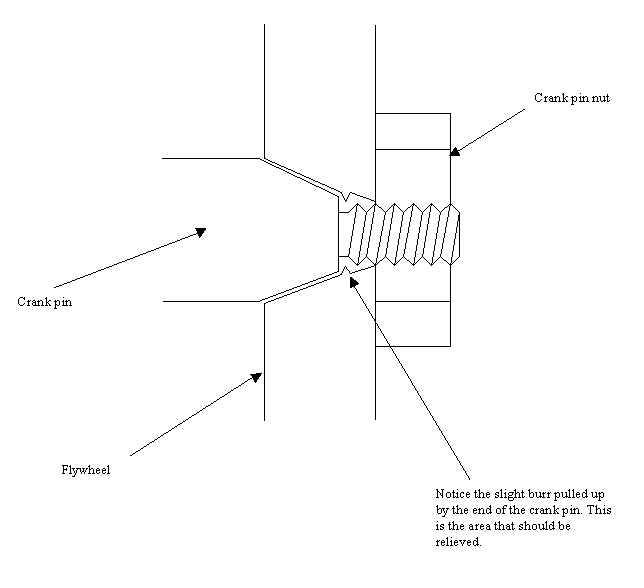
|
|
By
removing the burr you should hopefully allow the taper to reseat itself.
|
|
This
just about covers most of the problems encounters whilst crankshaft
rebuilding. If you find that you can’t get the crank to run truer than
0.005 inch the problem could be that the flywheel is defective, and you may
have to get new wheels. Usually you can true the crank to under 0.001 inch,
but on an M20 you could happily run it with about 0.003 inch (the bearings
will usually allow for this, but obviously the closer that you can get
absolute zero the better, as the engine will be smoother.
Good
luck! If you have any problems regarding crankshaft rebuilding please do not
hesitate to ring me on +44151 200 9161 (evenings)
Thanks
to Jake Plumb (for doing the drawings!)
©
Dave Plumb 2007
|